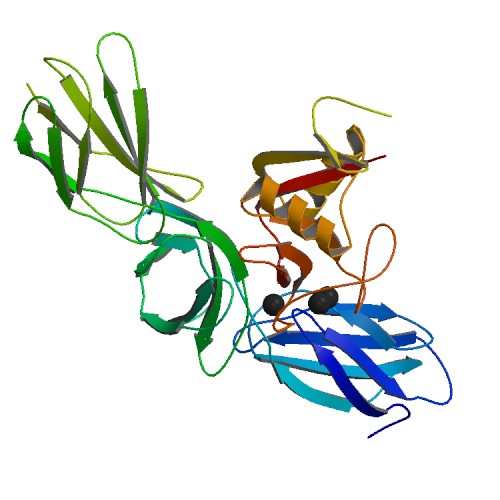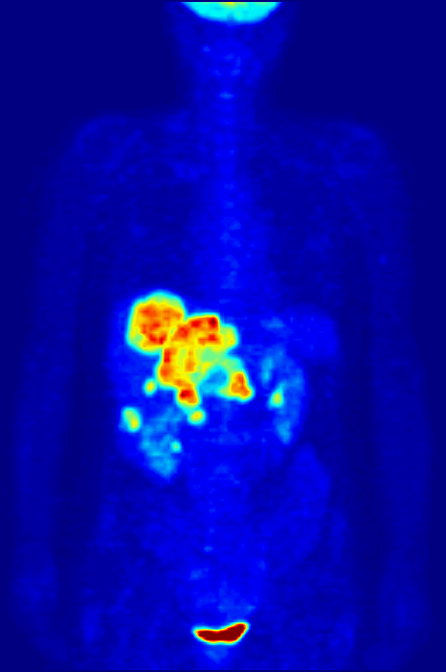|
Synaptic Vesicle Protein 2A
Synaptic vesicle glycoprotein 2A (SV2A) is a transmembrane protein belonging to a family of keratan sulfate proteoglycans, located on the synaptic vesicles of mammalian neuronal and endocrine cells. It's encoded by the ''SV2A'' gene. SV2A is the most widely expressed isoform of the SV2 family (which also includes the SV2B and SV2C proteins) found in all brain regions. The role of the SV2 proteins is not well understood, however they are thought to be involved in regulating vesicular processes. The SV2A protein is a target of the anti-epileptic drugs (anticonvulsants) levetiracetam and brivaracetam but it is not clear how these drug affect SV2A activity. Localisation SV2A is differentially expressed in both inhibitory GABAergic and excitatory glutamatergic terminals however it is not expressed in all synapses as was previously thought. There is a slightly stronger colocalisation between SV2A and GABA than glutamate and the association differs across brain regions and changes w ... [...More Info...] [...Related Items...] OR: [Wikipedia] [Google] [Baidu] |
Protein
Proteins are large biomolecules and macromolecules that comprise one or more long chains of amino acid residue (biochemistry), residues. Proteins perform a vast array of functions within organisms, including Enzyme catalysis, catalysing metabolic reactions, DNA replication, Cell signaling, responding to stimuli, providing Cytoskeleton, structure to cells and Fibrous protein, organisms, and Intracellular transport, transporting molecules from one location to another. Proteins differ from one another primarily in their sequence of amino acids, which is dictated by the Nucleic acid sequence, nucleotide sequence of their genes, and which usually results in protein folding into a specific Protein structure, 3D structure that determines its activity. A linear chain of amino acid residues is called a polypeptide. A protein contains at least one long polypeptide. Short polypeptides, containing less than 20–30 residues, are rarely considered to be proteins and are commonly called pep ... [...More Info...] [...Related Items...] OR: [Wikipedia] [Google] [Baidu] |
Proteoglycan
Proteoglycans are proteins that are heavily glycosylated. The basic proteoglycan unit consists of a "core protein" with one or more covalently attached glycosaminoglycan (GAG) chain(s). The point of attachment is a serine (Ser) residue to which the glycosaminoglycan is joined through a tetrasaccharide bridge (e.g. chondroitin sulfate- GlcA- Gal-Gal- Xyl-PROTEIN). The Ser residue is generally in the sequence -Ser- Gly-X-Gly- (where X can be any amino acid residue but proline), although not every protein with this sequence has an attached glycosaminoglycan. The chains are long, linear carbohydrate polymers that are negatively charged under physiological conditions due to the occurrence of sulfate and uronic acid groups. Proteoglycans occur in connective tissue. Types Proteoglycans are categorized by their relative size (large and small) and the nature of their glycosaminoglycan chains. Types include: Certain members are considered members of the "small leucine-rich pr ... [...More Info...] [...Related Items...] OR: [Wikipedia] [Google] [Baidu] |
Synaptic Vesicle
In a neuron, synaptic vesicles (or neurotransmitter vesicles) store various neurotransmitters that are exocytosis, released at the chemical synapse, synapse. The release is regulated by a voltage-dependent calcium channel. Vesicle (biology), Vesicles are essential for propagating nerve impulses between neurons and are constantly recreated by the cell (biology), cell. The area in the axon that holds groups of vesicles is an axon terminal or "terminal bouton". Up to 130 vesicles can be released per bouton over a ten-minute period of stimulation at 0.2 Hz. In the visual cortex of the human brain, synaptic vesicles have an average diameter of 39.5 nanometers (nm) with a standard deviation of 5.1 nm. Structure Synaptic vesicles are relatively simple because only a limited number of proteins fit into a sphere of 40 nm diameter. Purified vesicles have a protein:phospholipid ratio of 1:3 with a lipid composition of 40% phosphatidylcholine, 32% phosphatidylethanola ... [...More Info...] [...Related Items...] OR: [Wikipedia] [Google] [Baidu] |
Gene
In biology, the word gene has two meanings. The Mendelian gene is a basic unit of heredity. The molecular gene is a sequence of nucleotides in DNA that is transcribed to produce a functional RNA. There are two types of molecular genes: protein-coding genes and non-coding genes. During gene expression (the synthesis of Gene product, RNA or protein from a gene), DNA is first transcription (biology), copied into RNA. RNA can be non-coding RNA, directly functional or be the intermediate protein biosynthesis, template for the synthesis of a protein. The transmission of genes to an organism's offspring, is the basis of the inheritance of phenotypic traits from one generation to the next. These genes make up different DNA sequences, together called a genotype, that is specific to every given individual, within the gene pool of the population (biology), population of a given species. The genotype, along with environmental and developmental factors, ultimately determines the phenotype ... [...More Info...] [...Related Items...] OR: [Wikipedia] [Google] [Baidu] |
SV2B
Synaptic vesicle glycoprotein 2B is a protein that in humans is encoded by the ''SV2B'' gene. See also * SV2A Synaptic vesicle glycoprotein 2A (SV2A) is a transmembrane protein belonging to a family of keratan sulfate Proteoglycan, proteoglycans, located on the synaptic vesicle, synaptic vesicles of mammalian neuronal and endocrine cells. It's encoded by ... References Further reading * * * * * * {{gene-15-stub ... [...More Info...] [...Related Items...] OR: [Wikipedia] [Google] [Baidu] |
Anticonvulsant
Anticonvulsants (also known as antiepileptic drugs, antiseizure drugs, or anti-seizure medications (ASM)) are a diverse group of pharmacological agents used in the treatment of epileptic seizures. Anticonvulsants are also used in the treatment of bipolar disorder and borderline personality disorder, since many seem to act as mood stabilizers, and for the treatment of neuropathic pain. Anticonvulsants suppress the uncontrolled and excessive firing of neurons during seizures and in doing so can also prevent the spread of the seizure within the brain. Conventional antiepileptic drugs have diverse mechanisms of action but many block sodium channels or enhance γ-aminobutyric acid ( GABA) function. Several antiepileptic drugs have multiple or uncertain mechanisms of action. Next to voltage-gated sodium channels and components of the GABA system, their targets include GABAA receptors, the GABA transporter type 1, and GABA transaminase. Additional targets include voltage-gate ... [...More Info...] [...Related Items...] OR: [Wikipedia] [Google] [Baidu] |
Levetiracetam
Levetiracetam, sold under the brand name Keppra among others, is a novel antiepileptic drug. (medication) used to treat epilepsy. It is used for Focal seizure, partial-onset, Myoclonic epilepsy, myoclonic, or tonic–clonic seizures, and is taken either Oral administration, by mouth as an immediate release, immediate or extended release formulation or by intravenous, injection into a vein. Levetiracetam was discovered in 1992 through screening in audiogenic seizure susceptible mice and, 3 years later, was reported to exhibit saturable, stereospecific binding in brain to a approximately 90 kDa protein, later identified as the ubiquitous synaptic vesicle glycoprotein SV2A." The discovery process identifying levetiracetam's antiepileptic potential was unique because it challenged several dogmas of antiepileptic drug discovery, and thereby encountered skepticism from the epilepsy community. Common side effects of levetiracetam include sleepiness, dizziness, feeling tired, and ... [...More Info...] [...Related Items...] OR: [Wikipedia] [Google] [Baidu] |
Brivaracetam
Brivaracetam, sold under the brand name Briviact among others, is a chemical analog of levetiracetam, a racetam derivative with anticonvulsant (antiepileptic) properties. It has been approved since 2016. It is marketed by the pharmaceutical company UCB. It is used to treat partial-onset seizures with or without secondary generalisation, in combination with other antiepileptic drugs. Medical uses Brivaracetam is used to treat partial-onset seizures with or without secondary generalisation, in combination with other antiepileptic drugs. Efficacy and tolerability is comparable in general and Intellectual Disability populations. No data are available for its effectiveness and safety in people younger than 16 years of age. Drugs.com Adverse effects The most common adverse effects include sleepiness, dizziness, nausea and vomiting. More rarely, coordination problems and changes in behaviour (such as severe depression, aggression, hostility, impatience, rage, suicidal ideatio ... [...More Info...] [...Related Items...] OR: [Wikipedia] [Google] [Baidu] |
GABA
GABA (gamma-aminobutyric acid, γ-aminobutyric acid) is the chief inhibitory neurotransmitter in the developmentally mature mammalian central nervous system. Its principal role is reducing neuronal excitability throughout the nervous system. GABA is sold as a dietary supplement in many countries. It has been traditionally thought that exogenous GABA (i.e., taken as a supplement) does not cross the blood–brain barrier, but data obtained from more recent research (2010s) in rats describes the notion as being unclear. The carboxylate form of GABA is γ-aminobutyrate. Function Neurotransmitter Two general classes of GABA receptor are known: * GABAA in which the receptor is part of a ligand-gated ion channel complex * GABAB metabotropic receptors, which are G protein-coupled receptors that open or close ion channels via intermediaries (G proteins) Neurons that produce GABA as their output are called GABAergic neurons, and have chiefly inhibitory action at receptors in t ... [...More Info...] [...Related Items...] OR: [Wikipedia] [Google] [Baidu] |
Glutamate (neurotransmitter)
In neuroscience, glutamate is the anion of glutamic acid in its role as a neurotransmitter (a chemical that nerve cells use to send signals to other cells). It is by a wide margin the most abundant excitatory neurotransmitter in the vertebrate nervous system. It is used by every major excitatory function in the vertebrate brain, accounting in total for well over 90% of the synaptic connections in the human brain. It also serves as the primary neurotransmitter for some localized brain regions, such as cerebellum granule cells. Biochemical receptors for glutamate fall into three major classes, known as AMPA receptors, NMDA receptors, and metabotropic glutamate receptors. A fourth class, known as kainate receptors, are similar in many respects to AMPA receptors, but much less abundant. Many synapses use multiple types of glutamate receptors. AMPA receptors are ionotropic receptors specialized for fast excitation: in many synapses they produce excitatory electrical responses in ... [...More Info...] [...Related Items...] OR: [Wikipedia] [Google] [Baidu] |
Positron Emission Tomography
Positron emission tomography (PET) is a functional imaging technique that uses radioactive substances known as radiotracers to visualize and measure changes in metabolic processes, and in other physiological activities including blood flow, regional chemical composition, and absorption. Different tracers are used for various imaging purposes, depending on the target process within the body, such as: * Fluorodeoxyglucose ( 18F">sup>18FDG or FDG) is commonly used to detect cancer; * 18Fodium fluoride">sup>18Fodium fluoride (Na18F) is widely used for detecting bone formation; * Oxygen-15 (15O) is sometimes used to measure blood flow. PET is a common imaging technique, a medical scintillography technique used in nuclear medicine. A radiopharmaceutical—a radioisotope attached to a drug—is injected into the body as a tracer. When the radiopharmaceutical undergoes beta plus decay, a positron is emitted, and when the positron interacts with an ordinary electron, the tw ... [...More Info...] [...Related Items...] OR: [Wikipedia] [Google] [Baidu] |
UCB (company)
UCB (Union Chimique Belge) is a multinational biopharmaceutical company headquartered in Brussels, Belgium. UCB is an international company with revenue of €4.178 billion in 2016 which focuses primarily on research and development, specifically involving medications centered on epilepsy, Parkinson's disease, and Crohn's disease. The company's efforts are focused on treatments for severe diseases treated by specialists, particularly in the fields of central nervous system (CNS) disorders (including epilepsy), inflammatory disorders (including allergy), and oncology. Every three years, the company presents the UCB Award under the patronage of the Queen Elisabeth Medical Foundation to promote neuroscience research. The winner of this award is selected by an independent scientific committee. History UCB was founded on 18 January 1928 by Emmanuel Janssen, a Belgian businessman. Initially focused on industrial chemicals (it was one of the first companies to distill ammonia fro ... [...More Info...] [...Related Items...] OR: [Wikipedia] [Google] [Baidu] |





